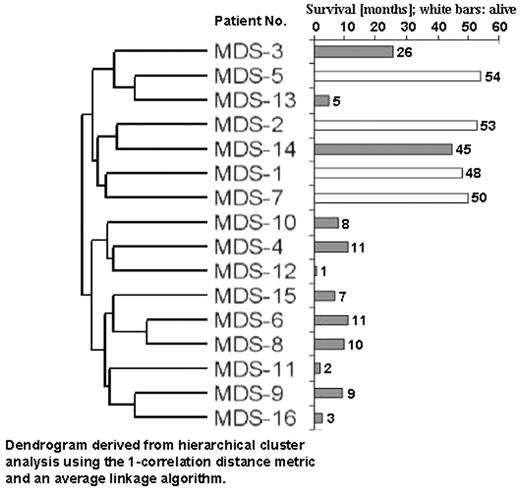Abstract
The biology of myelodysplastic syndromes (MDS) is reflected in aberrant transcription levels of the myeloid lineage. It was the purpose of this study to provide potential novel therapeutic targets by identifying molecular alterations that are pertinent to myelodysplastic syndromes.
cDNA from bone marrow-derived CD34+ hematopoietic stem and progenitor cells from 6 healthy persons, and 16 patients with MDS (Table 1) was hybridized to cDNA arrays comprising 1185 well-characterized genes.
We used the complete cDNA array expression values to build a dendrogram including all samples under investigation.
Interestingly, patient survival had a striking impact on our gene signature for it was the parameter that had the strongest statistical association with the segregation of our MDS patients into 2 sub clusters (Figure 1). We examined whether this segregation of MDS patients was associated with age, gender, MDS-type according to FAB, WHO, IPSS, karyotype or survival. We determined correlation coefficients and found “survival” to be the parameter with the strongest statistically significant association with the segregation of MDS patients into 2 sub clusters (Spearman = 0.697, P = 0.003). The WHO type was less significantly associated (Spearman = 0.537, P = 0.032), and the FAB type did not reach statistical significance (Spearman = 0.492, P = 0.053).
Transcriptional changes that are associated with short survival may also indicate to potential novel therapeutic targets. Since median age of patients with MDS is 70 at diagnosis, the majority of patients are not suitable for therapies that are not well tolerated. Moreover, some patients have a nearly normal life expectancy. Ideally, new therapeutic agents should, therefore, be tailored for patients with short survival and be well-tolerated like e.g. Bevacizumab and Cetuximab. But, we could not find increased expression of Bevacizumab and Cetuximab related EGFR- or VEGFR-target genes in CD34+ cells from MDS patients with short survival.
In sum, there are transcriptional alterations that are strongly associated with short survival, and thus valuable for prognostication of patients with MDS.
Classification, and karyotypes of patients with MDS who were analyzed by means of cDNA array analysis
| Patient No. . | Age/ Sex . | FAB (a) . | IPSS (b) . | WHO (c) . | Karyotype . |
|---|---|---|---|---|---|
| (a) FAB, French-American-British cooperative group classification, (b) IPSS, international prognostic scoring system; int, intermediate, (c) WHO, World Health Organization classification | |||||
| 1 | 61/ F | RA | int-I | RCMD | 46, XX, 13q- |
| 2 | 68/ F | RA | int-I | 5q- | 46, XX, 5q-, 12p- |
| 3 | 62/ M | RA | int-I | RCMD | 47, XY, +8 |
| 4 | 50/ M | RA | int-I | RCMD | 46, XY, t(X;1) |
| 5 | 18/ F | RA | low | PRA | 46, XX |
| 6 | 51/ M | RA | low | RCMD | 46, XY |
| 7 | 51 /F | RA | int-I | 5q- | 46, XX, 5q-, 12p |
| 8 | 75/ M | RAEB | high | RAEB II | 46, XY, 7q- |
| 9 | 79/ M | RAEB-t | high | sAML | complex |
| 10 | 68/ M | RAEB | int-II | RAEB-II | 46, XY |
| 11 | 70/ F | RAEB-t | high | sAML | 46, XX, 15q- |
| 12 | 52/ M | RAEB-t | high | sAML | complex |
| 13 | 72/ M | RAEB-t | high | sAML | complex |
| 14 | 75/ M | RAEB | int-I | RAEB-I | 46, XY |
| 15 | 72/ M | sAML/MDS | - | sAML | complex |
| 16 | 76/ M | sAML/MDS | - | sAML | 46, XY |
| Patient No. . | Age/ Sex . | FAB (a) . | IPSS (b) . | WHO (c) . | Karyotype . |
|---|---|---|---|---|---|
| (a) FAB, French-American-British cooperative group classification, (b) IPSS, international prognostic scoring system; int, intermediate, (c) WHO, World Health Organization classification | |||||
| 1 | 61/ F | RA | int-I | RCMD | 46, XX, 13q- |
| 2 | 68/ F | RA | int-I | 5q- | 46, XX, 5q-, 12p- |
| 3 | 62/ M | RA | int-I | RCMD | 47, XY, +8 |
| 4 | 50/ M | RA | int-I | RCMD | 46, XY, t(X;1) |
| 5 | 18/ F | RA | low | PRA | 46, XX |
| 6 | 51/ M | RA | low | RCMD | 46, XY |
| 7 | 51 /F | RA | int-I | 5q- | 46, XX, 5q-, 12p |
| 8 | 75/ M | RAEB | high | RAEB II | 46, XY, 7q- |
| 9 | 79/ M | RAEB-t | high | sAML | complex |
| 10 | 68/ M | RAEB | int-II | RAEB-II | 46, XY |
| 11 | 70/ F | RAEB-t | high | sAML | 46, XX, 15q- |
| 12 | 52/ M | RAEB-t | high | sAML | complex |
| 13 | 72/ M | RAEB-t | high | sAML | complex |
| 14 | 75/ M | RAEB | int-I | RAEB-I | 46, XY |
| 15 | 72/ M | sAML/MDS | - | sAML | complex |
| 16 | 76/ M | sAML/MDS | - | sAML | 46, XY |
Dendrogram derived from hierarchical cluster analysis using the 1-correlation distance metrics and an average linkage algorithm.
Dendrogram derived from hierarchical cluster analysis using the 1-correlation distance metrics and an average linkage algorithm.
Disclosure: No relevant conflicts of interest to declare.
Author notes
Corresponding author


This feature is available to Subscribers Only
Sign In or Create an Account Close Modal